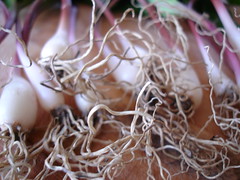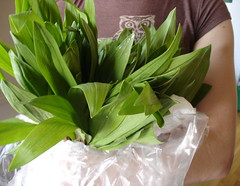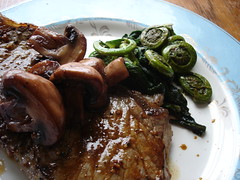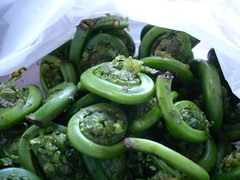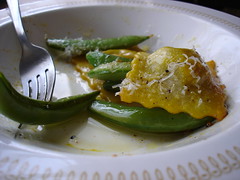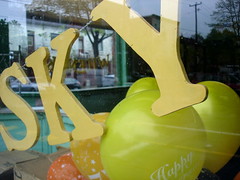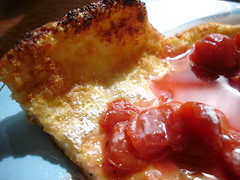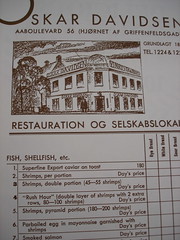No, that's not yet another egregious typo up there in the title. We only had about 4-5 hours to play with, so making it to Michigan and back was completely out of the question. Plus, for the kind of Michigan we were looking for, it's not clear crossing the Peace Bridge from Windsor into Detroit would have done us much good. We were in search of Michigans, the legendary hot dog concoctions, not Michigan, the state, so we headed to the town which, if it isn't the official Michigans capital of the world, most definitely is the Michigans capital of New York's North Country: Plattsburgh.
Prior to September of last year, we were pretty ignorant of Plattsburgh. We knew it sat on Lake Champlain and that it was a college town. We knew it had a pretty nice downtown core visible from Amtrak's Montreal-New York Adirondack Express, but, aside from that, our attitude towards Plattsburgh was one typical of a lot of Montrealers: we couldn't see past the strip malls, gas stations, and fast food chains on the edge of town. Then we received our October 2006 issue of Gourmet, read Jane and Michael Stern's "Roadfood" piece on Plattsburgh and its Michigans specialists, and suddenly we were seeing the town with new eyes. We started talking about Michigans with some frequency and Plattsburgh suddenly got vaulted towards the top of our road trip wish-list. Plattsburgh's Michigans became such an obsession, in fact, that in February, on our way down to New York City, I had to physically restrain Michelle when our train pulled into Plattsburgh because of her desperate attempts to disembark and blindly score "just one Michigan, just one lousy Michigan" before the train pulled out again (without her parka, I should add).
The strange thing about all this is that neither of us had ever met a chili dog (for that, in essence, is what a Michigan is) we really liked--it had never occurred to either of us that a chili dog could actually be a good thing. Then, suddenly, after reading the Sterns' account of this "small, porky frank bedded in a cream-soft bun and topped with mustard, onions, and a sauce made from a little tomato, a lot of spice, and finely ground beef" it all made sense. "Of course," we thought. "What's the problem?" Okay, the mustard seemed a little bizarre, and then there was that whole business with the nomenclature (why this hot dog + "Texas Red" became known as a Michigan in Plattsburgh is anybody's guess, although the Sterns' mention one credible story involving a transplanted Michigander who introduced the chili dog to Plattsburgh when sales on her mustard and sauerkraut-topped dogs went flat). But aside from that...
Anyway, after all that "talk, talk, talk" we finally made it down to Plattsburgh in search of Michigans yesterday, inspired by a Montreal-style Michigan we sampled earlier in the week, and intrigued by the vast differences between Michigans on opposite sides of the border (Montreal's are made with a meaty spaghetti sauce). Plus, it was nice out and we were in the mood for a drive along Lake Champlain, so we fired up our car and headed for the border.
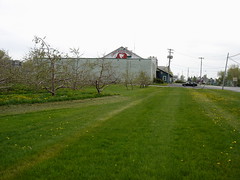 fig. a: Chazy Orchards, Chazy, NY
fig. a: Chazy Orchards, Chazy, NY
Shortly after crossing into New York we came across the famous Chazy Orchards, the ones we'd heard about last year from Mr. Safian. If you look closely you'll notice three things: 1) that's our car there in the parking lot, 2) that's Michelle sitting in the passenger seat of our car, 3) and that sign for Chazy Orchards reads "Largest McIntosh Orchard..." What you can't see is that the bottom reads "In the World." The image, oddly, shows a map of North America on the face of a huge McIntosh. Stranger still, the map of North America is missing Canada. Very interesting...
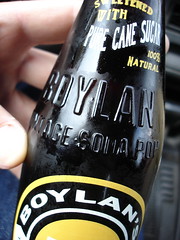 fig. b: Boylan's root beer
fig. b: Boylan's root beer
A little further down the road we came across Conroy's Organics. We were hoping we might find some ramps that we could try to smuggle back into Quebec, but all we came across was some gorgeous, but pricey, asparagus. As a consolation prize I bought myself a Boylan's root beer, the first of three soft drinks I'd guzzle (completely uncharacteristically) during the course of our short hop, and easily the best.
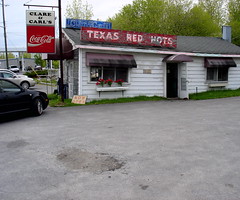 fig. c: Clare & Carl's, Plattsburgh, NY
fig. c: Clare & Carl's, Plattsburgh, NY
The Sterns mention three Michigans stands in their article: Gus's, McSweeney's, and Clare & Carl's. We had an unbelievably easy time finding the first two--they were within a 1/4 mile of each other--but locating Clare & Carl's was another matter. The article doesn't provide much in the way of directions, but we're usually pretty good at sussing these things out regardless. What added to the confusion this time around was that although Gus's is listed as being at 3 Cumberland Head Road, McSweeney's is listed at 535 N. Margaret Street, and Clare & Carl's is listed at 4729 U.S. Route 9, all three establishments are essentially on the very same stretch of road, U.S. Route 9. Two virtually side-by-side on the north end of town (Gus's and McSweeney's), and the other (Clare & Carl's) two miles to the south of downtown Plattsburgh. Anyway, although McSweeney's seemed to get the best rating when it came to their chili, the Sterns' description of Clare & Carl's was the one that had us the most intrigued, so that's where we went first and we were glad we did.
First stop: Clare & Carl's
Clare & Carl's is a wonderfully decrepit hot dog stand that dates back to 1942. It's so weather-beaten, in fact, that it looks like it's sinking back into the ground on which it was erected (a fact that the cartoon on the back of the Clare & Carl's t-shirts worn by the servers accentuates to hilarious effect). The interior is tiny: just a gorgeous vintage U-shaped counter and a small kitchen out back. There are also picnic tables for those who want to dine al fresco and you always have the option of getting carhop service, too. That's right: carhop service. In the 21st century.
 fig. d: graffiti, Clare & Carl's, Plattsburgh, NY
fig. d: graffiti, Clare & Carl's, Plattsburgh, NY
The whole place is very photogenic.
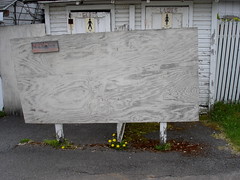 fig. e: conveniences, Clare & Carl's, Plattsburgh, NY
fig. e: conveniences, Clare & Carl's, Plattsburgh, NY
Right down to their washrooms.
More importantly, though, their Michigans are outrageously good. Their chili is made with finely ground beef and it's rich and flavorful, with no sweet to it and just a little bit of heat. Onions are a must, and you have the option of having them as a topping or "buried" under the dog and the sauce. Mustard is provided on the side. I didn't dare add mustard--I was having too good a time already--but Michelle cleverly applied mustard to half of hers so she could run her very own taste test. Afterwards she swore the mustard had added "a little something" that actually took the combo to new heights.
Suffice to say, we left Clare & Carl's completely enamored. We promised each other then and there that Clare & Carl's would become a regular part of our travels between Montreal and points south.
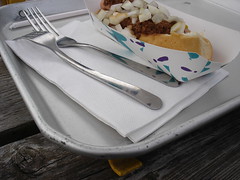 fig. f: McSweeney's Michigan w/ onions, Plattsburgh, NY
fig. f: McSweeney's Michigan w/ onions, Plattsburgh, NY
Next stop: McSweeney's.
We thought we might find a cluster of lit-heads--online lit-heads, to be precise--archly nibbling their Michigans and slurping back their "sauceburgers" then irritating the staff by repeatedly asking, "Uh, is Timothy working today?" and then chortling, but instead we found ourselves in the presence of a car club. A Smart car club. A Canadian Smart car club. Who knew? We certainly didn't, and we were horrified to find out such things exist. This was certainly not the band of lovable eccentrics that take part in that London - Brighton antique car rally you see in Genevieve (1953). Here, instead, was a group of people who hadn't banded together out of a love of restoring cars, but simply because they'd happened to buy the same brand of car right off the showroom floor. Now that's kinship. Plus, they'd each taken their supposedly eco-friendly cars on a road trip--a group road trip. We couldn't help but think that maybe renting a van might have been friendlier on the environment. Anyway, the spectacle of this, er, Smart car club wasn't particularly easy on the stomach, but we had serious research to complete so we took a deep breath and soldiered on.
At only 16 years of age, McSweeney's is the youngest of Plattsburgh's red-hots stands. It's bright and spanky-looking on the outside and has all the charm of a Long John Silvers on the inside. We ordered our two Michigans and opted to sit outside at a picnic table even if the Smart car club was busy revving their engines. McSweeney's Michigans sauce was the most authentically chili-like of the Michigans we sampled. The ground beef was coarser than Clare & Carl's and the sauce was much spicier, more complex. Their Michigans came with mustard as a standard feature, and when I tasted the entire ensemble together I suddenly understood Michelle's preference. The mustard added yet another layer of spice, of warmth, and somehow it still worked. All in all, I was pretty impressed by my McSweeney's Michigan--and I couldn't get over the fact that they too offered carhop service (just check out that tray!)--but Michelle felt pretty strongly that Clare & Carl's had not been unseated. There was no question who was #1 on the ambiance front, that's for sure.
Final stop: Gus's.
Gus's was the place that intrigued us the least even if its history does date back to 1951. Reading over the Sterns' section on Gus's again, I'm not sure why. Our intuition turned out to be correct, though. Gus's Michigan (Michelle had bowed out by this time, leaving me with daunting challenge of completing the Plattsburgh Michigans trifecta solo) was very good, but it was sweeter than either of the previous two and somehow not quite as distinctive. Plus, nothing about Gus's indicated that it had been in business for 56 years. The interior was pure "family dining" at its most banal. But I didn't let any of that get to me--I polished off that Gus's red hot in seconds flat.
Final results:
Win: Clare & Carl's
Place: McSweeney's
Show: Gus's
Would we do it again? Absolutely. Do we need to go to all three ever again? Nah. You'll find us at Clare & Carl's with our Michigans, coleslaw, a Coke, and a smile.
aj
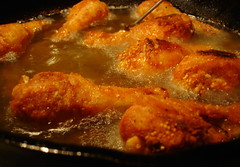 fig. a: mmm, fried chicken
fig. a: mmm, fried chicken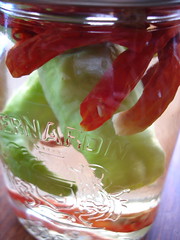 fig. b: yes! pepper vinegar
fig. b: yes! pepper vinegar